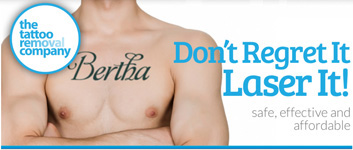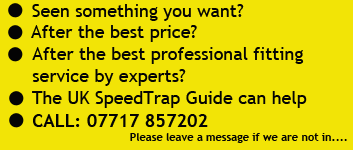Laser Guns, LTI 20-20,Prolaser
II, RIEGL Laser Guns.
The Laser Gun fires a harmless,
narrow laser beam and computes distance using the simple change
of position over time formula, rather than a radio frequency shift.
While radar projects a broad, cone-shaped beam 200 to 400 feet
wide, with an effective range of only a few hundred yards, the
Laser Gun beam widens to just 3 feet at a range of 1000 feet in
most cases. Individual vehicles can be isolated during heavy traffic
due to laser's pinpoint accuracy.
Well, it seems that although
LIDAR is good at measuring speed and distance, the guns are a
bit of a pain to use. Fog, rain, dust, vehicle halogen headlights,
movement, (just to mention a few) make the guns more difficult
to use than radar. They can't be used inside a nice warm police
car either unless the window is down most won't work through glass
without error.
When used for distances over 400 yards they usually have to be
tripod mounted or steadied to stop beam shake and instability.
With handheld laser, a 1
degree movement of the operator's hand moves the beam 6-7ft for
every 100 yards the beam travels from the gun.
 Laser
speed detection renders radar detectors useless due to laser's
tight beam-width (two feet at 800 feet) a radar/laser detector
mounted outside the beam's strike-zone will give little or no
warning, and thus isolates the most flagrant speeders, however
a Laser or Radar Jammer will help if mounted well on your vehicle,
some of the systems sold will give you enough time to slow before
the next reading is taken, for more info see my links page for
more information. Laser
speed detection renders radar detectors useless due to laser's
tight beam-width (two feet at 800 feet) a radar/laser detector
mounted outside the beam's strike-zone will give little or no
warning, and thus isolates the most flagrant speeders, however
a Laser or Radar Jammer will help if mounted well on your vehicle,
some of the systems sold will give you enough time to slow before
the next reading is taken, for more info see my links page for
more information.
Most Laser Guns measure speed
in 1/3 second, not nearly enough time for a driver to react to
a laser detector warning.
But to acquire a reading,
the laser beam must bounce directly back to the laser gun from
a flat reflective surface. Consequently, laser guns are specifically
aimed at a vehicle's licence plate or front headlights, and the
gun's computer looks for the strongest return signal

Above: Typical
printout of an offending vehicle, used for evidence.

Above: Photograph
taken on the Northants LTI 20-20 Laser camera.
My
Thanks to Bob for this one... £40 and 3 points for 92mph
Calibration: Laser
devices are self-calibrating. The device itself performs verification
at power on, but the police must also check the device at the
start and end of each tour of duty of the device. They often check
the device against a patrol car with a calibrated speedometer,
referred to as calibration verification. A record of the check
must be made - usually in the officer's pocket book. If a calibration
defect is found, the unit is returned to the manufacturer. Once
a year the calibration is performed by the manufacturer or a certified
agent, and a certificate of calibration is issued to the police.
A visible sticker showing the date of calibration must be fixed
to the device along with lead seals similar to what you would
have on your electric meter.
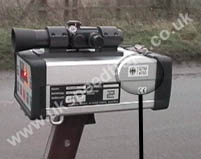 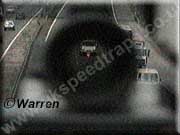
Above Left: RIEGL
and position of calibration sticker
Above Right: Laser sight view, clearly showing the red
sighting dot on the number plate of the car.
They are being used more and
more, either Hand Held, resting on a wing mirror of an unmarked
car, or on a tripod with a video camera linked to it for the Video
evidence quite often printing out a picture of an offending vehicle.
These are usually accompanied by a unmarked car or van. The most
common place to site the is on a motorway bridge, usually the
small farm crossing bridges. They also have a tendency to site
them on bridges in roadwork's, to blend in.
Use of laser guns on a bridge
has its own rules, they are to be as close as possible to the
centre line of the lane being targeted to reduce cosine effect.
They must also carry out a height check from the height of the
bridge to the road below and multiply this figure by 10. This
then becomes the minimum distance the ACPO allow for speed measurement.
For example, if he's on a bridge 9 metres above the motorway,
the minimum distance to target a vehicle is 90 metres.
Kent, Manchester and Wales
Police do this the most.
Common support vehicles are
unmarked vans, but Kent also like Citroen AX cars. On a motorway
they set the limit at about 85mph or above.
This is far becoming one of
the most common mobile ways to nick you.
Examples of laser guns in use:
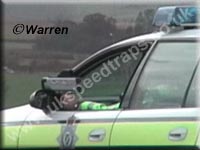
Above: Prolaser
II in use on the wing mirror. A1 Lincs.
 
Above: Police using LTI 20-20 in Unmarked Ford, Manchester M6/M62
in a known accident blackspot area.
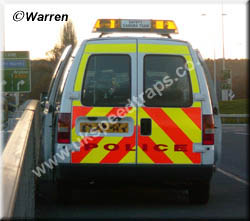 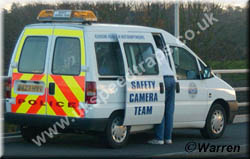
Above: Police using LTI 20-20 and camera in marked van, note the
yellow lights, is that to throw you off the sent. Northamptonshire
M1 Jun 15
They don't like you taking pictures, but they have taken pictures
of over 18000 offenders in less than three months.
Specifications
Marksman Specifications
LTI 20-20
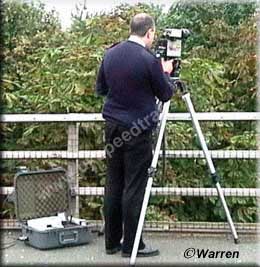
Dimensions: 3.5 in x 5 in x 8 in
Weight: 4.5 lbs
Speed Measurement Distance: 30 ft to 3500 ft
300mts With Video Camera
Speed Maximum: +200 mph to -200 mph (accurate zero reading) Accuracy:
+/- 1 mph
Acquisition Time: 0.3 seconds
Range Measurement Distance: 30 ft to 3500 ft Accuracy: +/- 6 inches
Acquisition Time: 0.3 seconds
Targeting
Pin-point beam (3 milliradian divergence, 3 ft wide at 1000 ft)
Adjustable illuminated red dot slight
AutoCapture triggering
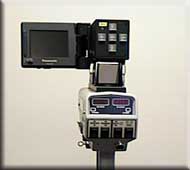
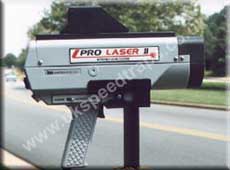
Left: ProLaser
Gun Right: ProLaser with Camera fitted.
ProKustom's ProLaser
II
Standard Features and Capabilities:
- Stationary operation.
- Laser beam just 3.5 feet wide at 1000
feet
- Continuous speed readings are seen
inside the HUD for as long as the trigger is squeezed; releasing
the trigger locks the speed.
- The settable Range Control allows
an officer to determine the distance at which Prolaser II
will pick up a target, especially useful in school zones.
- In Stopwatch Mode, operate at angles
to the target.
- Can be operated through a windshield.
- Selectable direction: An oncoming
target speed is confirmed by a plus (+) in front of the speed;
a receding target speed is confirmed by a minus (-).
- Audibly verifying target acquisition
is a series of beeps that become a steady tone when Prolaser
II is making a direct hit.
Standard Features and Capabilities
with Camera
- Video and image capture unit utilises
a miniature colour video camera aimed through the speed measuring
unit's HUD in order to capture vehicle speed, distance, and
identification.
- System camera provides 450 lines of
horizontal resolution with a 200 mm lens. This configuration
allows licence plate identification up to 250 ft.
- System incorporates a 3-inch colour
LCD monitor mounted on the side of the camera to be used as
a viewfinder for vehicle tracking and verifying proper operation
of the system.
- Pertinent data (vehicle speed, range,
time/date, speed limit, threshold speed, operator and location)
appears in the form of an overlay mask recorded on the high
resolution S-videotape or stored in a digital format.
- Records can be printed in seconds
standard colour video printer
RIEGL LR90-235/P & FG21-P
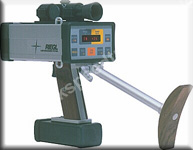 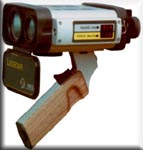
Left: RIEGL
LR90-235/P Right: RIEGL FG21-P
RIEGL LR90-235/P Details
Maximum Approved Distance:
> 600 m
Minimum Approved Distance: 30 m
Accuracy: 1 km/h
Measuring time: 0.3 second
Maximum speed: 300 km/h
Weight: approx. 2,0 kg
Example of the spread of the Laser
Beam over distance. (RIEGL LR90)

RIEGL FG21-P Details
Maximum Approved Distance:
> 1000 m
Minimum Approved Distance: 30 m
Accuracy: +/-3 km/h (to 100 km/h) +/-3% of the measured value
(over 100 km/h)
Target-acquisition area: approx. 25 cm @ 100m distance, 250 cm
@ 1000 m
Measuring time: 0.5 second (between 0.4s and max. 1 second)
Distance measuring accuracy: +/-10 cm
Maximum speed: 250 km/h
Integrated Head UP display
Efficient jammer recognition
The device can be used comfortably and reliably by hand
Weight: approx. 1,85 kg
What you see in the display of the
RIEGL FG21-P Display.
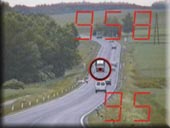 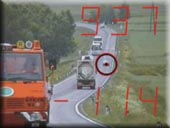
Left: A lorry shown at 958 metres away, speed 95 km/h heading towards
laser gun
Right: A car shown at 937 metres away, speed 114 km/h
(- tells the operator that the
vehicle is going away from the laser gun) heading away from
laser gun.
On my travels I managed to seek out a Laser Speed Trap and
spoke to the policeman operating it, he enthusiastically showed
me how it worked.......
He demonstrated on a motorway
bridge over the M25 near Sevenoaks, first looking through
the camera viewfinder and lining up the tiny red laser dot on
the outside lane. An 8mm video recorder in the back of his car
is linked to a printer programmed to produce pictures only when
he zaps cars doing 90mph and above.
One approached the red dot in his viewfinder and he squeezed the
camera trigger. The machine emitted an electronic "bleep" and
the printer churned out a picture of a Cavalier doing 91mph. "If
people knew the effectiveness of this system, they wouldn't get
out of bed," he said enthusiastically. "Earlier this morning I
caught 16 motorists in twenty minutes in an East Kent village.
They were all doing over 44mph in a 30mph zone."
"Bleep" and he trapped another.
"Bleep" and another; each hit costs the driver a £40 fine and
three penalty points on his licence. "If I was to target drivers
doing 80 and above I would do virtually everybody on the motorway,
but that would just clog up the system. People are speeding all
the time but you have to be sensible. I am after the really dangerous
drivers, people doing 90mph and above. They'll get an automatic
fixed penalty. Anyone doing over 100mph will be prosecuted and
in most cases disqualified."
"Catching speeding motorists
could be as easy as taking candy from a baby, if we had more of
these units" he said with a big grin.
He reacted angrily to the
suggestion that police time might be better spent catching robbers
and rapists than speeding motorists. "Tell that to someone whose
child has been killed by a speeding motorist," he said. 'If we
were to ignore speeding, more lives would be lost. We have a responsibility
to make sure that doesn't happen."
Things they don't tell you about
Laser Guns
Similar to radar, laser
cannot be used in the rain, snow, or high dust environments. Laser
takes precise aiming, radar does not. Like radar, laser is susceptible
to cosine error.
Cosine Error is the angle
from the 0 degree perpendicular to the target vehicle. The
greater the cosine angle the greater the error. However, cosine
error is always in favour of the motorist, i.e. speed readings
will be proportionally less than actual speed of the target vehicle.
Sweep Error is manifested
when the laser is aimed at one part of the vehicle, say the licence
plate, and due to the motion of the operator, the laser also targets
a side mirror during the same trigger pull. Sweep Error adds to
the real speed of the target vehicle.
Refection Error is next. On very hot days with low humidity a visible mirage/reflection
of the target vehicle is created. In many cases, when the laser
is aimed at the target vehicle the infrared beam also receives
readings from both the target vehicle and the mirage causing a
Sweep error.
Overexposure Error is
last. When a laser gun receives an extremely powerful reflective
signal, such as a sunflare off a vehicle, the computer's timer
can not see the return of the 904 nanometer signal it sent. It
can not compute a speed-reading. In general, the laser gun is
looking for the strongest return reflection of its own emitted
beam for speed computation.
A recent court case in
the USA has thrown a doubt on the accuracy of the LTI 20-20.
At a recess in the proceedings the defendant's lawyer picked up
the LTI 20-20 from the courtroom bench and proceeded to aim it
at the back wall of the courtroom. To his complete astonishment,
the gun registered a speed of 5.4mph. Bear in mind that he was
aiming at a wall inside a building. He also noted how difficult
it was to maintain his target accuracy by simply hand holding
the device, with the registered speed fluctuating between -2.2mph
and +5.4mph. A net error of nearly 8mph on a stationary object
20m away!
The defendant managed to successfully
prove that not only was the gun too heavy to use to reliably pick
out a vehicle at 150metres without a tripod, but that it's technology
was fundamentally flawed.
Several US states have now banned the
LTI 20-20 due to it being inaccurate
in certain conditions......... More Here.
Learn more
about the Police Laser System here in the LASER FAQ
|



